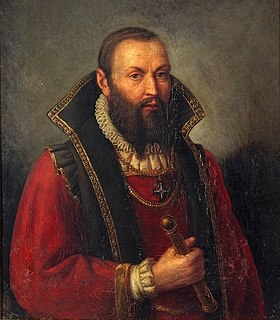Frederick II was King of Denmark and Norway and Duke of Schleswig from 1559 until his death.
 W
WAlexander Guagnini was an Venetian-born Polish writer, military officer, chronicler and historian of Italian heritage. He is known as a Crown Rotmistrz of Poland and Commandant of Vitebsk. Guagnini fought for the Polish-Lithuanian Commonwealth in the Livonian War and the Moldavian Magnate Wars.
 W
WIvan IV Vasilyevich, commonly known as Ivan the Terrible, was the Grand Prince of Moscow from 1533 to 1547 and the first Tsar of Russia from 1547 to 1584.
 W
WHenrikki Laavunpoika of Kankainen, or Henrik Klasson Horn , was a Swedish military officer and Governor-General of Finland. He was an ancestor of the noble Swedish family, Horn af Kanckas.
 W
WGotthard Kettler, Duke of Courland was the last Master of the Livonian Order and the first Duke of Courland and Semigallia.
 W
WMagnus of Denmark or Magnus of Holstein was a Prince of Denmark, Duke of Holstein, and a member of the House of Oldenburg. As a vassal of Tsar Ivan IV of Russia, he was the titular King of Livonia from 1570 to 1578.
 W
WAntonio Possevino was a Jesuit protagonist of Counter Reformation as a papal diplomat and a Jesuit controversialist, encyclopedist and bibliographer. He acted as papal legate and the first Jesuit to visit Moscow, vicar general of Sweden, Denmark and northern islands, Muscovy, Livonia, Rus, Hungary, Pomerania, Saxony between 1578 and 1586.
 W
WPrince Roman Fedorovich Sanguszko was a soldier and statesman of the Grand Duchy of Lithuania. He served as governor (voivode) of Bracław and was hetman of Lithuania from 1567 until his death. He fought at the Battle of Ula in 1564 and belonged to the nesuhoizhskoy branch of the House of Sanguszko.
 W
WSimeon Bekbulatovich was a Russian statesman of Tatar origin, descendant of Genghis Khan, who briefly served as a figurehead ruler of Russia.